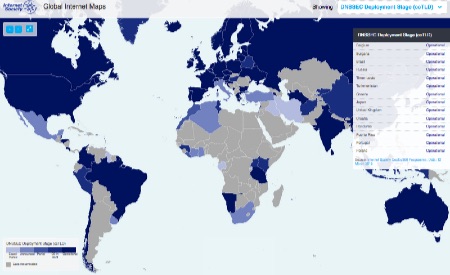
Unless you've been offline or ignoring social media for the past couple of weeks you've no doubt seen the dueling "livestreaming wars" between the iOS applications
Meerkat and
Periscope. Perhaps you've viewed some of the streams... or broadcast some yourself.
Given that I do live streaming as part of my employment, I'm fascinated by these new and emerging apps. They also remind me of what Qik tried to do back in the mid-2000s before Skype bought Qik in 2011 and promptly shut the service down. (Only to have Qik re-emerge recently as a different kind of mobile messaging service from Skype.)
I've been playing with both Meerkat and Periscope and offer a few quick thoughts based on my own experience. I will be exploring these apps more... but want to record some comments for today's For Immediate Release podcast episode and want to use this post as a basis for that report.
The beauty of both of these apps is that it makes it absolutely TRIVIAL for someone to start live streaming. Just login with Twitter and press the a button to start broadcasting live to the world!!!
Here are some thoughts about both apps and then some thoughts on this larger new era of simple live streaming.
Periscope
Periscope was purchased by Twitter and apparently had the app in development for quite some time. Things I like:
- Polished user interface.
- The "hearts" that you can give to "like" something are fun.
- The replay capability is useful... although it seems the stored videos are only available for something like 24 hours.
Things I am not as excited about:
- The comments appear and then disappear... and there seems to be no way I could find to go back and see them again, without replaying the video. Given that in a couple of trials I was driving with my iPhone on my dashboard, I could NOT read the comments while driving.
- No horizontal orientation... you have to hold the phone in a vertical orientation. Yes, you can turn the phone sideways and hold it horizontally, but all the comments and hearts still come in the vertical orientation.
- Several people viewing my live streams indicated they had connection issues.
Meerkat
Meerkat was out before Periscope and captured a great amount of attention at SXSW and recent conferences. Things I like:
- Comments are scrollable within the stream. You can read them later (during the time of the stream).
- You can hold the camera horizontally.
- Comments can be out onto Twitter.
- You can answer comments by text within the app (although is this really important? I'm not sure).
- So far no connection issues for me... but I've seen others have issues.
Things I am not as excited about:
- Comments are gone after the stream.
- No replay capability.
Changing Our Expectation Around Privacy
I think there is a larger societal question we need to be thinking about - that person walking down the street holding a phone up can be streaming everything they see live out onto the public Internet?
Intellectual Property
To that point... there are a whole host of intellectual property issues that I think we as a society will need to address. Nothing whatsoever technically prevents someone from streaming a concert or any presentation live. There are many artists and speakers who charge for their events and don't want them live streamed.
Cost
People in the mobile telecommunications companies have to be loving this - here are ways that people will generate a great amount of mobile data very quickly! Unless people have "unlimited" telecom data plans, they are going to be running up some good-sized costs. Great for the telcos... not so great for the producers. However, any event with "free" WiFi around could easily attract a good number of streams.
Bandwidth
All of these live video streams will create some interesting additional pressures on the Internet's infrastructure. Particularly in situations where there is "asymmetrical" connections, i.e. you have a faster download than upload speed. The streaming out of events could create a much larger requirement for upload speeds than there has been before.
Digital Divide
All of which feeds into a question about the "digital divide". The Internet users who are in regions with good Internet connectivity will be both able to produce/broadcast and also able to consume all these live streams. What about people in other parts of the world where bandwidth is much more limited? How will they be able to participate in this new era of live streaming?
Similarly, these Periscope and Meerket apps are right now only available on Apple's iOS platform... what if you can't afford an iPhone?
Ephemeral Moments and FOMO
One of the interesting elements of Meerkat is that once the stream is gone... it's gone. It's ephemeral like Snapchat... it's there... it's gone. You have to be there to see it and participate.
This leads to the "Fear Of Missing Out" (FOMO) and the "need" to be part of that.
Periscope allows replays, which changes it a bit. Now it's a recording available for some time. I'm not sure which is better.
[Side note: I don't know how truly "ephemeral" either Meerkat or Periscope is... the streams have to go through some server out there and the server could easily record any and all streams.]
Rich Interaction
What I did find very cool about using both Periscope and Meerkat was the rich interaction I could have with the audience. They were able to leave comments that I could react to right within the stream itself. They were able to guide the conversation... asking questions that I then answered.
In several cases friends I knew joined into my live streams. In one case this meant I switched to speaking German because I knew a German friend was watching. In another I switched the camera to view myself so that a friend I hadn't seen in a few years could see what I look like today.
It was great in so many ways to have this rich interaction during a stream. I'm looking forward to trying this out in some events in the future.
Final Thoughts...
... I'm very intrigued by these new applications. They make live streaming so incredibly simple and easy for anyone to do. I think we do have some of these larger societal issues and conventions to think through... but our era of ubiquitous live streaming is definitely upon us.
I see great potential for these apps in live streaming of events... for citizen journalism... breaking news... bearing witness to unfolding events... marketing/webinar types of events... indie musicians and artists... tutorials...
The reality of course is that we'll also see a lot of incredibly mundane and boring live streams. We'll probably see a good deal of porn. We'll see other ways to abuse live streams that will appall us. That's what always happens with any new service.
I will continue testing the apps. I want to see what else they can do. I want to explore more of the technical aspects - things such as their actual bandwidth usage. I want to know if any of them work over IPv6. (Sadly, expecting them NOT to do so.) I want to understand how secure they are.
So I'll be writing more... as I have time to do so.
Meanwhile, these are just some initial thoughts.
What do you think? Are you experimenting with either Periscope or Meerkat? Or some other similar app?
P.S. See also "Periscope and live video are changing the internet forever", a good take on how these apps are already changing live news...
If you found this post interesting or useful, please consider either:




